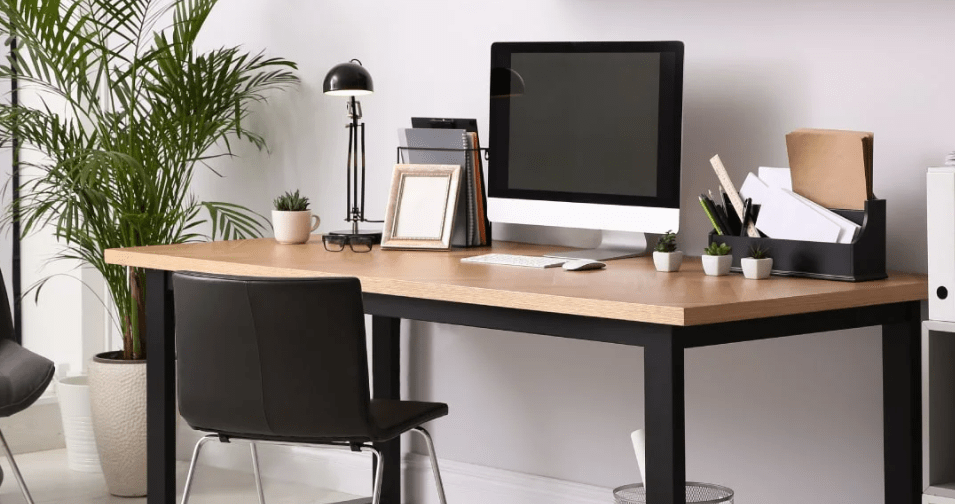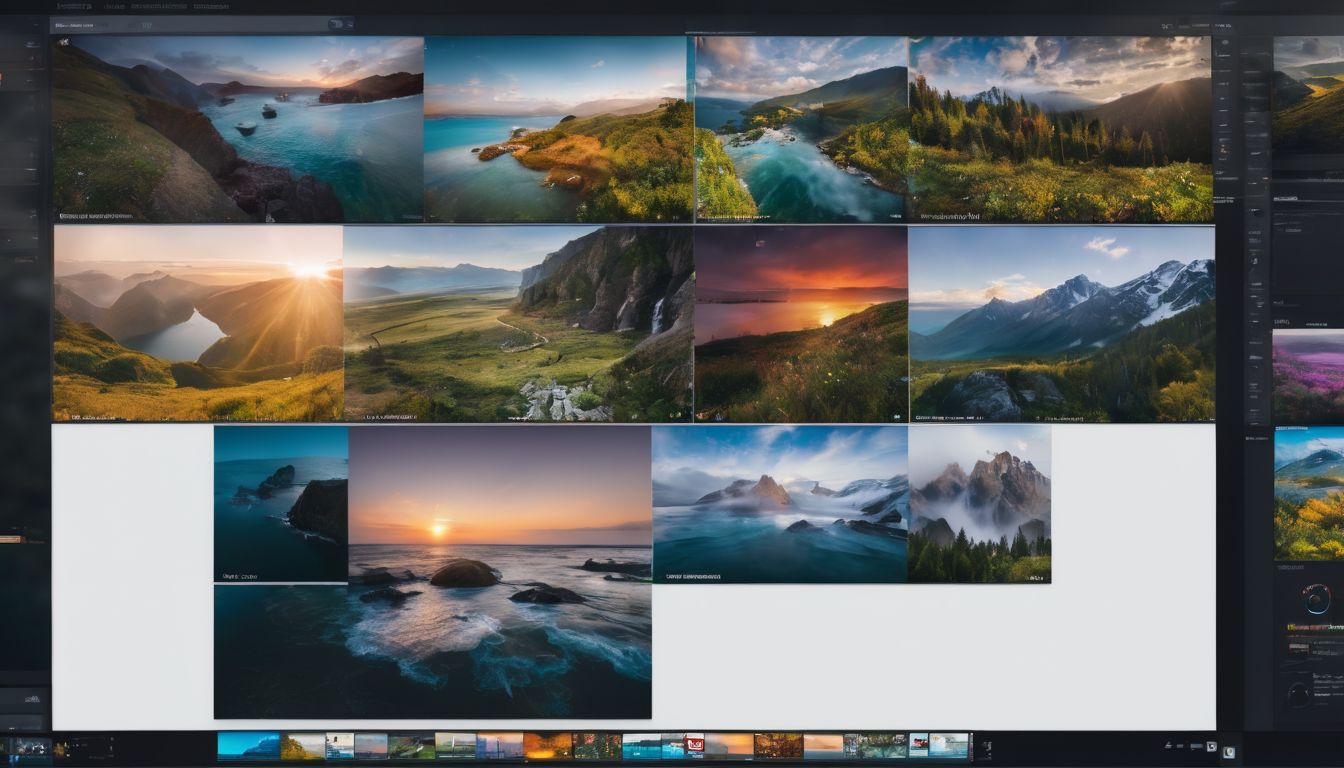Are you often losing important documents on your cluttered work desk? Studies show that a tidy workspace can increase productivity and reduce stress. Our article dives into 15 practical and creative ideas to help you transform your messy desk into an organized, efficient workstation.
Keep reading to discover how a well-organized desk could be your secret weapon for success!
Key Takeaways
- A well-organized work desk increases productivity and reduces stress and anxiety.
- Clearing space, creating zones, using storage containers and organizers, labeling everything, and adding personal touches are effective ways to organize your work desk.
- Transitioning from physical to digital tools can streamline your workspace and boost productivity.
- Essential items for a productive work desk include a trash can, notebook, filing system, office supplies, and a charging station.
Importance of a Well-Organized Work Desk

A well-organized work desk is crucial for boosting productivity and reducing stress and anxiety.
Boosts productivity
A clean desk makes work easier. When things are in order, you can find what you need fast. The extra time lets you get more done each day. A tidy workspace also helps your brain focus better.
There is less stuff to distract you from the tasks at hand. So, an orderly desk means more work done in less time!
Reduces stress and anxiety
Having a neat desk helps calm your mind. No one likes seeing a mess all the time. A tidy desk means fewer things for your brain to worry about. You can focus on your work and not think about cleaning up.
This helps to lower stress and anxiety.
An organized workspace also makes you feel more in control. You don’t have to spend hours looking for that important paper or pen. Everything has its place! The less time you waste, the less stressed out you will be.
How to Organize Your Work Desk

To organize your work desk, start by clearing some space and creating designated zones for different tasks. Use storage containers and organizers to keep items neatly stowed away, and label everything for easy access.
Adding inspiration and personal touches can also make your workspace more inviting and organized.
Clear some space
Having a messy desk can slow you down. It is important to clear some space. Here are some tips:
- Take all items off your desk.
- Only keep things you use every day.
- Store less used items in desk drawers.
- Throw away any trash or useless items.
- Make a spot for your computer or laptop.
- Make another spot for writing and reading.
Create zones
Creating zones on your work desk can help you stay organized and focused. Here are some ideas for creating different areas on your desk:
| Zone | Description |
|---|---|
| Computer Zone | Set up a designated space for your computer or laptop. Keep this area clear of clutter and only have the essentials, like your monitor, keyboard, and mouse. |
| Writing Zone | If you do a lot of writing or note-taking, create a separate area for this task. Have a notebook or pad of paper, pens, and any other writing tools you need within easy reach. |
| Supplies Zone | Dedicate an area for office supplies like staplers, tape dispensers, and scissors. Use organizers or small containers to keep everything tidy and easily accessible. |
| Inspiration Zone | Include a small space where you can display photos, quotes, or other items that inspire you. This can help boost motivation and creativity while working. |
| Reference Materials Zone | If you frequently refer to books, manuals, or other resources, designate an area on your desk to keep them nearby. Use bookends or shelf organizers to keep them upright and organized. |
Use storage containers and organizers
To keep your work desk organized and clutter-free, consider using storage containers and organizers. These can help you keep your office supplies, documents, and other items neatly arranged and easily accessible. Here are some ideas to get you started:
- Use drawer dividers or trays to separate and organize small items like paper clips, sticky notes, and USB drives.
- Invest in desktop organizers with compartments or drawers to store pens, pencils, scissors, and other frequently used tools.
- Consider using stacking bins or shelf dividers to create additional storage space on top of your desk or shelves.
- Use file holders or magazine racks to keep important documents upright and prevent them from getting lost or damaged.
- Utilize hanging wall pockets or file folders to store papers that need immediate attention or that you refer to frequently.
- Label each storage container or organizer so that you can quickly find what you need without rummaging through everything.
Label everything
Labeling everything on your work desk is a simple yet effective way to stay organized and increase productivity. Here are some items that you should consider labeling:
- Drawers: Use labels to indicate the contents of each drawer, such as pens, notepads, or office supplies.
- Folders and files: Label your folders and files based on their contents or categories, making it easier to find what you need quickly.
- Cables and cords: Use small labels or cable tags to identify the purpose of each cord so that you can easily locate the right one when needed.
- Storage bins and containers: Label storage bins and containers with the items they hold, such as stationery, electronic accessories, or paperwork.
- Desk sections: If you have different sections on your desk for various tasks, label them accordingly. For example, label one section as “Inbox” for incoming documents and another as “To Do” for ongoing tasks.
Add inspiration and personal touches
Adding inspiration and personal touches to your work desk can help create a more enjoyable workspace. Here are some ideas to make your desk feel more personalized:
- Hang up motivational quotes or artwork that inspire you.
- Place photos of loved ones or pets on your desk for a touch of happiness.
- Keep a small plant or succulent on your desk to add a touch of greenery and improve air quality.
- Use colorful office supplies or stationery that reflect your style and personality.
- Incorporate a small shelf or display area to showcase meaningful items like awards, certificates, or mementos.
Transitioning From Physical to Digital
Transitioning from physical to digital can help streamline your work desk and increase productivity. By embracing digital tools and minimizing the use of physical items, you can create a more efficient workspace.
One important step is to scan and digitize documents, reducing clutter and making them easily accessible on your computer or cloud storage. This eliminates the need for bulky file cabinets and allows for quick searching and sharing of files.
Another way to transition to a digital workspace is by utilizing online task management tools and calendar apps. These tools help you stay organized, set reminders, and collaborate with colleagues seamlessly.
Additionally, consider using note-taking apps instead of traditional paper notebooks to jot down ideas or make lists.
To reduce the number of physical office supplies on your desk, invest in wireless devices such as a wireless mouse and keyboard. This will free up workspace surface area by eliminating tangled cords.
When transitioning from physical to digital, it’s important to back up your data regularly. Whether you choose an external hard drive or cloud storage service, having backups ensures that you don’t lose important files if something happens to your device.
By transitioning from physical to digital at your work desk, you can declutter your space, improve organization efficiency, save time searching for documents or notes, and ultimately boost productivity in your workflow.
Essential Items to Have at Your Desk
Having essential items at your desk is crucial for a productive work environment. Make sure to include a trash can, notebook, filing system, office supplies, and a charging station for all your electronic devices.
Trash can
Keep a small trash can at your work desk to make it easy to dispose of any waste. Having a dedicated place for garbage will keep your workspace clean and organized. You won’t have to get up and leave your desk every time you need to throw something away, saving you time and keeping you focused on your work.
A trash can is an essential item for maintaining an efficient and clutter-free work environment.
Notebook
Having a notebook at your work desk is essential for staying organized and increasing productivity. It allows you to jot down important notes, ideas, and tasks that need to be completed.
With a notebook by your side, you can easily reference information without having to search through digital files or rely on memory alone. Additionally, writing things down helps improve focus and retention of information.
You can use the notebook to create to-do lists, track progress on projects, brainstorm new ideas, or capture meeting notes. By having a dedicated space for all your thoughts and plans, you can stay on top of your tasks and ensure nothing gets overlooked.
Filing system
A filing system is an essential part of a well-organized work desk. It helps to keep important documents and papers easily accessible and reduces clutter on the desk. By categorizing files and using labels, you can quickly find what you need without wasting time searching through piles of papers.
A filing cabinet or file holder can be used to store physical files, while digital files can be organized in folders on your computer. Having a proper filing system not only increases productivity but also ensures that important information is kept safe and secure.
So, make sure to implement a filing system as part of your desk organization strategy for maximum efficiency at work.
Office supplies
Having the right office supplies at your desk is essential for staying organized and productive. Make sure you have a trash can nearby to keep your workspace tidy and clutter-free.
It’s also helpful to have a notebook for jotting down important information or to-do lists. A filing system is crucial for keeping documents organized and easily accessible when needed.
And of course, don’t forget about the basic office supplies like pens, pencils, paper clips, and sticky notes. Having these items readily available will save you time searching for them and allow you to focus on your work more efficiently.
Charging station
Having a designated charging station at your work desk is essential for staying productive. It allows you to keep all your electronic devices organized and fully charged. By having a designated spot for charging, you’ll never have to search for cables or outlets again.
You can use storage containers or cable organizers to keep cords neat and tidy, minimizing clutter on your desk. A charging station also helps prevent the frustration of running out of battery during important tasks.
With everything in one place, you can easily grab your charged device and continue working without interruption.
Creative Desk Organization Ideas
Utilize wall space for additional storage and organization, making use of shelves, hooks, or hanging file holders.
Use wall space
Utilize the wall space around your desk to create additional storage and keep your workspace clutter-free. Here are some ideas:
- Hang a pegboard or grid system on the wall to easily hang and organize office supplies, such as pens, scissors, and notepads.
- Install floating shelves above your desk to store books, folders, or decorative items.
- Use magnetic strips or hooks to hold metal objects like paperclips or keys.
- Mount file holders or magazine racks on the wall to keep important documents within easy reach.
- Hang a whiteboard or bulletin board for notes, reminders, and to – do lists.
Make use of empty books
Empty books can be repurposed for desk organization. Here are some ideas:
- Turn a book into a hidden storage compartment by cutting out the pages.
- Use a book as a stand for your computer or tablet to elevate your screen.
- Place small office supplies, like paper clips and sticky notes, inside a hollowed – out book.
- Stack books horizontally to create additional shelves on your desk.
- Use a book as a mousepad or to keep your keyboard elevated.
- Arrange books vertically to act as bookends and keep loose papers in place.
- Use an empty book as a coaster for drinks to protect your desk surface.
- Store cables and cords inside the pages of a book to keep them organized and hidden from view.
DIY cord labels
Wouldn’t it be helpful to easily identify which cord goes where? Try these DIY cord labeling ideas:
- Use colored tape: Wrap different colors of electrical tape around each cord near the plug. This way, you can quickly tell which cord belongs to which device.
- Label with tags: Attach small paper tags or adhesive labels to the end of each cord. Write the name of the device on the tag so you can easily identify it.
- Wrapping with washi tape: Wrap a piece of colorful washi tape around each cord, leaving some space for writing. Use a permanent marker to write the name of the device or function on the tape.
- Cable clips and ties: Use cable clips or ties to neatly bundle cords together. You can also attach small labels to these clips or ties for easy identification.
- Bread bag clips: Repurpose bread bag clips by labeling them with device names and attaching them to cords.
- Heat shrink tubing: For a more permanent solution, use heat shrink tubing to label cords. Write on a piece of heat shrink tubing before heating it with a heat gun or hairdryer to wrap around the cord.
Maximize under-desk space
- Utilize a rolling cart or storage bins to store items under your desk.
- Use a cable management system to keep cords organized and out of the way.
- Install hooks or shelves on the underside of the desk to hang or store items.
- Consider using a monitor stand with built-in storage compartments for additional space.
- Utilize hanging file organizers or portable file boxes to keep important documents within reach but off the desk surface.
- Invest in a small filing cabinet or drawer unit that fits underneath your desk.
- Use vertical storage solutions, such as wall-mounted shelves, to make use of unused wall space above or next to your desk.
- Store rarely-used items in labeled bins and place them under your desk for easy access when needed.
- Consider using a laptop stand with storage compartments to elevate your laptop and create extra space on your desk surface.
- Attach a pegboard or grid panel to the side of your desk for additional storage options like hanging baskets and hooks.
- Opt for slim and space-saving office accessories, such as a compact printer or an all-in-one device, that can fit comfortably under your desk.
- Keep frequently used paperwork in a desktop organizer with drawers or dividers so they’re easily accessible without cluttering up the workspace surface.
- Utilize stackable storage containers that can be placed under your desk while still allowing easy access to their contents.
- Install adjustable shelving units above your desk that can be customized to fit various office supplies and personal belongings.
- Make use of vertical hanging files attached to the side of your desk for quick access to important documents without taking up valuable workspace.
Utilize on-demand self storage
You can also utilize on-demand self storage to keep your work desk organized. Here’s how:
- Rent a storage unit or use a cloud – based storage service to store files and documents that you don’t need immediate access to.
- Use external hard drives or USB flash drives to store digital files, freeing up space on your computer.
- Keep backup copies of important files in a secure location, both physically and digitally.
- Store rarely used office supplies, such as extra pens or notebooks, in the storage unit to declutter your desk.
- Utilize storage bins or shelves near your desk for easy access to frequently used items while keeping them neatly organized.
Create designated work areas
To increase productivity and efficiency, it’s important to create designated work areas on your desk. Here are some ideas:
- Use a separate area for your computer or laptop, ensuring it is easily accessible.
- Designate a space for writing tasks, with pens, pencils, and paper readily available.
- Set up a specific area for organizing documents and files, using file holders or trays.
- Create a zone for office supplies, such as staplers, tape dispensers, and calculators.
- Have a separate area for personal items or decorative touches, like photos or plants.
Conclusion
In conclusion, by implementing these 15 work desk organization ideas, you can significantly increase your productivity. Creating zones, using storage containers and organizers, labeling everything, and adding personal touches will help you stay organized and focused.
So tidy up that desk and watch your productivity soar!
Frequently Asked Questions
How can I organize my work desk to increase productivity?
You can organize your work desk by decluttering, using storage containers, creating designated spaces for different items, and keeping frequently used items within reach.
What are some effective desk organization ideas for improving productivity?
Some effective desk organization ideas include using drawer dividers, cable management solutions, wall-mounted organizers, and utilizing a bulletin board or whiteboard for important reminders and notes.
Why is it important to have an organized work desk?
Having an organized work desk helps improve focus and efficiency by reducing distractions and allowing quick access to necessary tools or documents.
Can an organized work desk help reduce stress?
Yes, an organized work desk can help reduce stress because it creates a visually pleasing and clutter-free environment that promotes a sense of calmness and control.
Are there any benefits to having a well-organized workspace?
Yes, having a well-organized workspace improves productivity, saves time searching for things, enhances concentration abilities, boosts creativity, and creates a professional impression.



